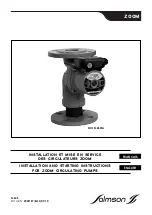
20
ENGLISH
Autodos M
MA60-10E
ENGLISH
Autodos M
MA60-10E
Alarm diodes
The alarm diodes indicate an alert with a flashing light. The alarm relay is an alternating contact free from electric potential.
It alternates when the diode is flashing (this means that a shut off unit indicates an alarm). Upon reset/acknowledgement of
alarm, the alarm relay alternates back but the alarm diode continues to be lit if the alarm is still active or is shut off if no alarm is
active. Indications are made for low alarms, high alarms, dosage errors and flow errors.
Dosing is affected by alarm as follows:
Flow error
stops all dosing (starts when flow is correct)
Low alarm pH
stops chlorine dosing (starts when value is within limits)
High alarm pH
stops chlorine dosing (starts when value is within limits)
Low alarm redox / chlorine
no effect on dosing
High alarm redox / chlorine
no effect on dosing
Low alarm free/combined chlorine
no effect on dosing
High alarm free/combined chlorine
no effect on dosing
Dosing error pH
stops all dosing (starts after Reset)
Dosing error free/combined chlorine
stops chlorine dosing (starts after Reset)
Alarm level switch
no effect on dosing
All alarms have a 5-second delay
Alarm delay
The high and low alarms have a delay of 5–600 seconds (set in electrode-specific configuration).
The flow switch alarm has a delay of 0–30 minutes (set in system configuration).
This is how the alarm delay works
• Delay time is counted up when an “alarm condition” applies.
• Delay time is counted down when an “alarm condition” does not apply.
•
“Alarm” is activated (LED flashes) when delay time has reached the set delay time limit.
• “Alarm” is deactivated when the alarm is reset with the
Reset
button [15] and when delay time has been counted down to zero.
Alarm relay delay
The alarm relay has a delay of 0–30 minutes (set in system configuration). Function as follows:
• The delay time is counted up when there is an alarm that has not been reset and when the alarm delay time has not been
zeroed.
• The delay time is reset when it is not counted up (as per condition above).
• The alarm relay is activated when the delay time has reached the set delay time limit.
•
Reset
[15] deactivates the alarm relay and resets the delay time.
Alarm reset
Alarm reset is carried out by pressing and holding the
Reset
button [15] for about one second until the LEDs stop flashing (and
the alarm relay is de-energized).
While the
Reset
button [15] is held depressed, the display(s) show text indicating which alarms were active when the button was
pressed (see chapter Troubleshoting on page 32, there you find all alarm codes and what they mean).
If several alarms are active, these are displayed at a 1-second interval.
The acknowledged, non-active alarms disappear when the button is released. Pressing the button again will display the
remaining active alarms.
Reset is not possible while Autodos M is in calibration mode.
The dosing time counter is always zeroed with a reset.
Showing uncalibrated values
Display of the factory-calibrated values (as if no calibration was carried out since delivery from the factory) can be carried out by
pressing the
Function
[11] and
Alarm low
[14] buttons simultaneously (also works during calibration).
NOTE: On Autodos M3 with acid/alkali dosing, these buttons are called
Set acid
[11] and
Alarm low
[14].
The function is a good troubleshooting aid if the electrodes are not functioning normally.
This function helps troubleshooting if the electrodes do not work as intended.
















































